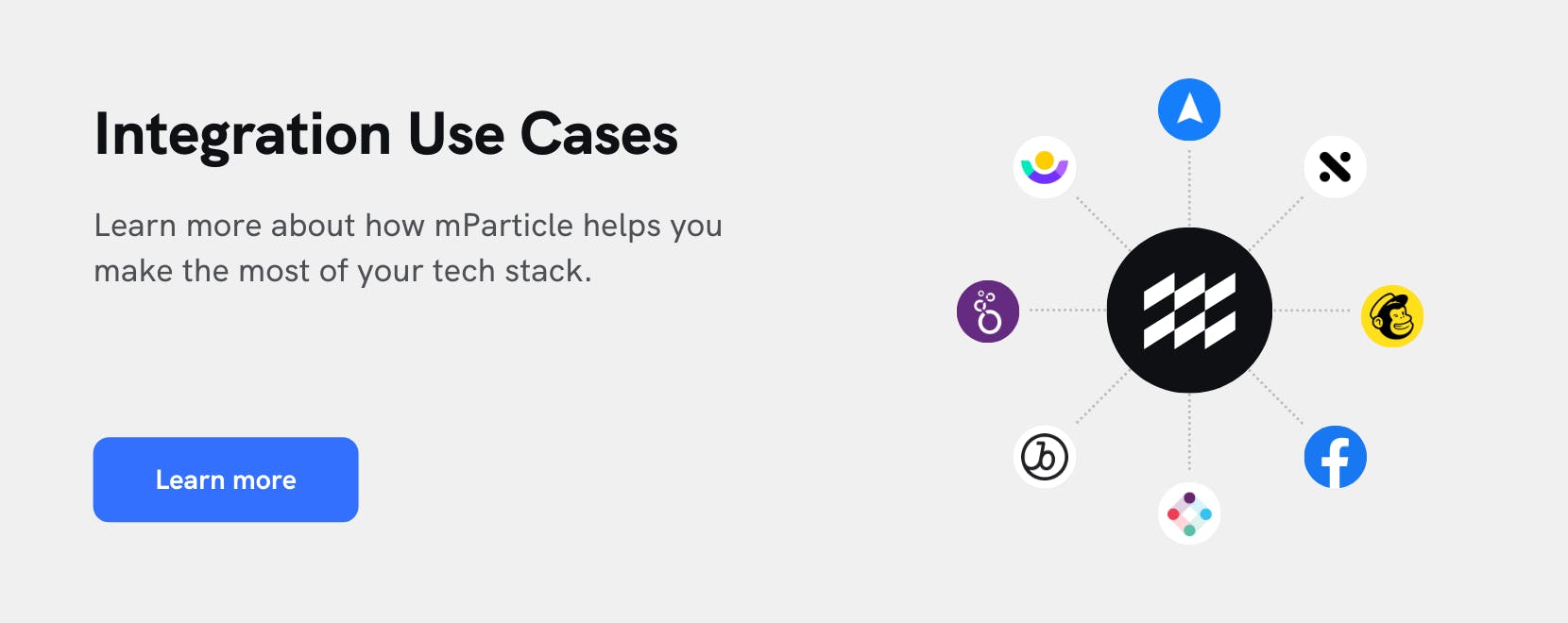When identity resolution goes wrong
mParticle CEO and Co-founder, Michael Katz, discusses why identity resolution is so critical for brands today, where mistakes can be made, and how mParticle can help.

Modern consumers have near-unlimited access to just about every service and product they may need, no matter where they may be, thanks to the rise of mobile and connected devices. But simply being accessible to consumers isn’t enough to warrant their attention, dollars, or loyalty. Today’s consumer expects highly personalized experiences tailored to their unique preferences, attributes, and previous interactions with brands thanks to the bar-raising customer experience from brands such as Burger King, Starbucks, Spotify, Airbnb, etc.
The challenge facing many modern brands is one of data quality; as more data is created and consumed, moving to and from more sources, more systems, more applications, and more endpoints, brands need to think about protecting data quality to ensure success along the product and customer lifecycle.
There is no shortage of data tools that allow developers to collect data, to merge data, to enforce a standard schema, and to integrate data into various systems, but an area most data integration tools often overlook is identity resolution; the process of merging the appropriate customer data into the appropriate customer profile. The real reason identity is so important is because it is the exact point where even properly collected and formatted data, can go bad. The right data merged into the wrong profile is, ultimately, still not right.
Identity resolution is the nucleus of any data strategy and teams that have not properly invested in a comprehensive identity strategy will end up facing a number of issues:
- Incomplete or duplicate profiles as known and unknown user activity is aggregated
- Potential noncompliance with personal data regulations
- Data hygiene issues resulting from a one-dimensional identity mapping, especially in businesses operating multi-sided marketplaces
- No access to a centralized, accurate, single view of the customer journey
- Inability to leverage customer data across channels for omnichannel marketing
Why identity resolution?
When it comes to customer data platforms, identity resolution is probably the single most misunderstood offering today. Identity resolution encompasses the process by which data is managed and merged given several forms of identity and associated data. Functionally, identity resolution is the governing process that decides whether customer data is assigned to new or existing profiles as customers engage with your digital properties over the course of their journey.
Let’s look at what can happen if proper value is not assigned to identity resolution.
1. You’re over-counting (and overpaying) across vendors
One of the most common pain points caused by poor identity resolution centers on how logged-in and logged-out activity is attributed to user profiles. People log into and out of apps and sites regularly, and many of the best brands strive to create frictionless paths through the funnel. For example, an eCommerce brand called Widgets.com that implements a guest checkout experience may have a customer that visits the site and begins the journey logged out, so the system recognizes them as a new user and appropriately creates a new customer profile. As that user continues to engage, this engagement data is appended to their profile.
But what happens if that user comes back a week later and decides that they want to log in?
As that user logs in, it’s clear that this same user was actually an avid shopper at Widgets.com and that they have an extensive profile that contains their various identities, as well as all of their past engagement and transactional data. If not properly merged, the brand is counting and paying for two users despite it being a single customer, which leads to poor analytics and inaccurate personalization. Downstream, having this kind of dirty data has a direct cost to the brand in terms of marketing spend and lifetime value as customers receive irrelevant messaging.
mParticle offers brands with a solution for just this problem with User Aliasing, which allows brands to programmatically merge anonymous user events with their logged-in events, providing brands with a complete, accurate view of their customers’ profile and event journeys as they move from being anonymous to authenticated across every touchpoint. With user aliasing, brands know that their customer profiles are persistent and include every engagement regardless of logged-in status, serving as a clean basis for initiatives across the organization.
2. You’re increasing your legal exposure and liability
An overly simplistic identity resolution strategy can lead to potential non-compliance with regulations such as GDPR, CCPA, or VPPA.
As a user logs in and out of apps and sites, brands need to create frictionless paths down the funnel while respecting users’ most updated consent decisions. When you know the same browser/device that’s engaging in a logged-out state is the same person who was logged in before, should you connect that behavior in that anonymous state to the last logged in user? A different user? The next user who logs in? There is no one size fits all approach.
For an eCommerce brand, this may be a very straightforward business decision, but for a media company, the Video Privacy Protection Act (VPPA) explicitly prohibits companies from merging known and anonymous data.
Most solutions force brands to choose one of the scenarios “because that’s just how the API works.” But what happens then when a user submits a GDPR Subject Access Request and sees data on purchases they never made, or thought they were making as a guest, tied to their name? What brands need is a solution that allows the solution to conform to their specific needs to remain compliant as privacy regulations evolve.
The system must rank order the importance of identities to match and merge profiles. Switching between anonymous and known states and merged is a common scenario that is treated differently by almost every company, so the right solution needs to be able to be flexible and extensible enough to meet brands’ specific compliance needs. mParticle is designed to help brands manage their highly identifying customer data, including consent decisions, while supporting compliance with privacy regulations, including GDPR and CCPA. Personally identifying data is collected and stored in either logically or physically separated identity space where it can be transformed, shared, and even deleted to maintain data control and transparency.
3. People aren’t who you thought they were
For some brands, individual users may be on both sides of the marketplace, making identity resolution even more critical because of the increased likelihood that engagement data is mapped to the wrong profile. Think users who buy and sell items from a site like eBay, or someone that uses Postmates as a consumer and as a weekend courier. Or, consider what happens if employees of the company also become consumers, and the employees’ accounts are all provisioned from the same computer. In these cases, if the primary identifiers are an email or an internally assigned user ID, data from engagements can be attributed to incorrect profiles or pollute otherwise accurate profiles with irrelevant data. Conversely, the brand may want to merge the data based on the presence of a secondary identity in order to better market to them. In any of these cases, brands need to be able to not only collect this data, they need to be able to collect it in real time, at a high scale, and be able to piece them into separate cohesive profiles.
To address this complex identity resolution issue, mParticle uses deterministic matching to build separate profiles for users operating on more than one side of a marketplace. Deterministic matching doesn’t rely on a single identifier, like an email or internally assigned user ID; instead, it collects two or more identifiers that have been directly observed together to match data to the right user. By leveraging deterministic matching, brands with multi-sided marketplaces can rest assured that engagement data from a courier, for example, is appended to that account instead of their personal consumer account, making it easier to understand how to improve the experience on both sides.
4. No “Single View of the Customer”
As consumers interact with brands across a number of different channels, each of those channels identifies users differently. In some channels, customers are primarily identified using a name, an email, or even a device ID. Without a solution that can account for the variance in identities and make matches via any set of identifiers, brands lose the “vaunted single view of the customer” and the consequence for them is that they are unable to provide the connected customer experience that modern consumers have now come to expect.
How many times have you heard a friend (or experienced it yourself maybe) describe their frustration after having a chat session that didn’t solve a problem, only to have to explain the whole situation again to a call center representative? The inability to resolve the identity of your friend in the chat session to the call center identity is exactly the reason already frustrated customers receive a poor customer experience when reaching out for help.
Without access to a complete, up-to-date customer record, teams across the organization are left to fly blind, leading to less-than-stellar experiences like the one detailed above. Using an API, mParticle ingests data from every source in your stack, standardizes it to ensure accuracy, and then uses deterministic matching to match it to an existing user profile and merge it or create a net-new user record. This record is easily accessed through the UI to key stakeholders, like the call center representative, to inform current and future engagements.
5. Missing out on omnichannel marketing
Given most brands’ customers engage with them across multiple channels, this boils down to one simple and important opportunity for marketers—behaviors exhibited in one channel can be leveraged for marketing to the same user in another channel. Furthermore, some channels are limited in what identifiers they can leverage for targeting due to technical constraints. Systems that are only able to match a cookie to, say, a hashed email upon sign-in to a website won’t allow marketers to seize this opportunity. Only a system that can match any set of identifiers from any channel truly enables omnichannel marketing.
As a centralized source of customer data, mParticle collects, cleanses, standardizes, and aggregates data produced across a brand’s engagement channels as they occur. This means that as a customer engages with a brand on one channel, that data is automatically collected and added to their profile through second- and third-party identifiers. This engagement data can then be used to direct how the brand engages with a customer on other channels and can be used to include or exclude customers from audiences and suppression lists to maximize the efficiency of marketing campaigns. So, if a customer clicks on an Instagram story ad for a specific product but doesn’t make that purchase, they may be added to a promotional email or ad campaign on another platform offering the same product to entice them to complete their purchase. With identity resolution doing the heavy lifting, customers get a better customer experience by receiving ads and offers that are directly relevant to their needs and interests while marketing teams improve the efficiency of their programs and conversion rates.
Key takeaways
Identity resolution is critical to data quality, and data quality is critical to brands’ success in the modern era where CX is expected to be personalized and consistent, independent of the touchpoint. Poor information architecture costs companies billions of dollars per year in poor CX and wasted marketing dollars. Identity resolution is the foundation to better engage with customers. Brands should solve foundational data challenges first and foremost, otherwise, data hygiene issues are almost guaranteed.
At mParticle, we make business personal; our platform was built to fix the operational pain points we have experienced collectively as we have built and deployed tools and created data-driven customer experiences. If you’d like to learn more about how mParticle’s identity resolution capabilities can help you engage with your customers more meaningfully and provide you with a clean, centralized database of customer data to guide your marketing, analytics, product, and operational processes, get in touch!




